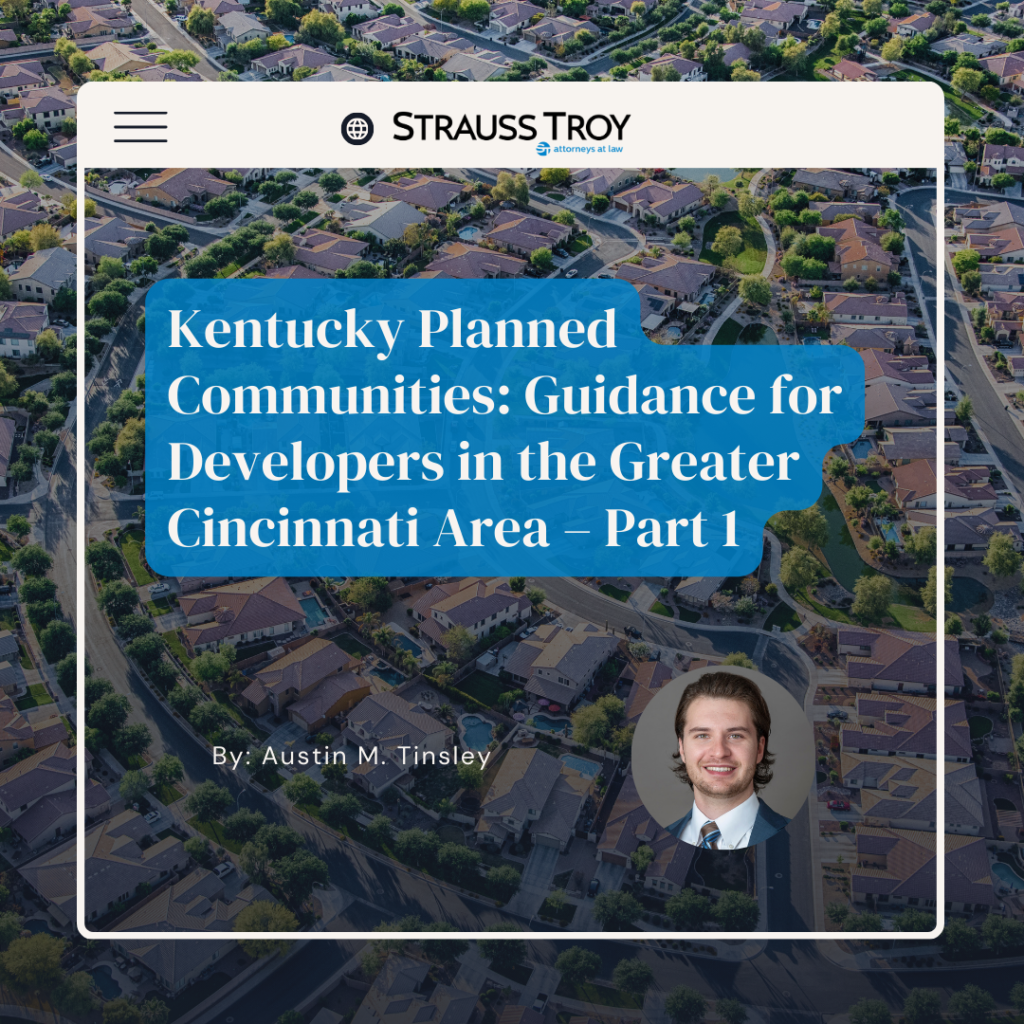By: Austin M. Tinsley
 Kentucky’s Planned Communities statute (KRS §§ 381.785 – 381.801) (the “Act”) took effect on June 29, 2023. This is an important update for real estate developers in the greater Cincinnati area because, prior to the Act and unlike states like Ohio, Kentucky did not have any statutes that addressed planned communities.
Kentucky’s Planned Communities statute (KRS §§ 381.785 – 381.801) (the “Act”) took effect on June 29, 2023. This is an important update for real estate developers in the greater Cincinnati area because, prior to the Act and unlike states like Ohio, Kentucky did not have any statutes that addressed planned communities.
This is the first article in a series that will survey key provisions of the Act, and compare the Act with Ohio law governing planned communities.
Key Definitions in Kentucky Planned Communities for Developers to be Aware
Under the Act, a “Planned community” is a group of residential dwellings, not including condominiums, which is composed of individual lots for which a deed, common plan or declaration requires that:
- “All owners become members of an association;
- Owners or the association hold or lease property or facilities for the benefit of all owners; or
- Owners support by membership fees or property or facilities for all owners to use.” KRS § 381.785(a)
A “residential dwelling” includes a building or portion of a building that is designed and used for occupancy of a single household. As such, such a dwelling cannot be used for business or commercial purposes. The building or portion of the building may include common walls, roofing, or other common structural elements.
A “Lot” is any plot or parcel of real property designated for separate ownership or occupancy either as shown in a subdivision plat of described in a declaration for the planned community.
An “Owner” includes the declarant or another person who owns a lot in a planned community, but excludes any person that has an interest in a lot solely as a security obligation.
Planned communities do not include any recorded deed, subdivision plat or plan, or declaration where lot owners only share maintenance expenses for shared or common roadways that provide access to multiple lots. Planned communities also cannot be created if a development or neighborhood does not currently have a homeowners association.
Therefore, if (1) a development or neighborhood does not meet the requirements in KRS 381.785(a), (2) lot owners only share maintenance expenses for common roadways, and (3) no homeowners association exists in a development or neighborhood, then the provisions of the Act are not applicable to that neighborhood or development.
A developer who establishes a planned community is known as the “Declarant”. The Declarant is “a person or entity, and their successors and assigns, that:
- (a) Executes and files a declaration that encumbers real property; or
- (b) Authorizes real property to be governed by a declaration, as part of the establishment or maintenance of a planned community.” KRS § 381.785(6)
A declarant establishes a planned community when it executes an instrument (commonly entitled a “Declaration”), which creates covenants, conditions, and restrictions over a neighborhood or development. The declarant must then file and record that declaration with the county records where the neighborhood or development is located.
The declarant must establish an association to govern the planned community no later than when the declarant conveys the first lot in the planned community to a purchaser. The declaration must include specific information for the governance of the association including but not limited to the number of persons on the board, the election method of the board, and the time for holding meetings.
Lastly, the Act does not specify a time limit on the declarant control period—when the developer controls and manages the association—instead, the Act merely indicates that the Declaration should specify a certain length of time for the control period. The developer control period cannot go on indefinitely.
The next article in this series will discuss the Act’s effect on current planned communities that exist in Kentucky, namely planned communities that came into existence prior to the effective date of the Act. The final article will compare the Kentucky laws with of Ohio.
Regardless of whether you seek to establish a planned community or understand the Act’s impact on an existing planned community, it is important to consult with an attorney to navigate the process.
For questions about the Act or other related issues, contact Austin M. Tinsley at 513-768-9709 or amtinsley@strausstroy.com. Austin regularly handles both commercial real estate and residential real estate matters, and is licensed in Ohio, Kentucky, and Indiana.

